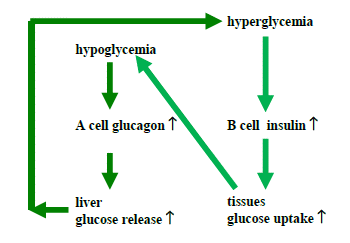Csaba Varga, PhD, Anikó Pósa, PhD, Krisztina Kedvesné Kupai: The metabolic syndrome
- The metabolic syndrome
- I. Introduction
- II. Historical survey
- III. Physiological basics
- III.1. Energy storage
- III.2. Regulation of lipid metabolism
- III.2.A. Adipose tissue distribution
- III.2.B. The endocrine function of adipose tissue
- III.2.B.a. Adiponectin
- III.2.B.b. Leptin
- III.2.B.c. Resistin
- III.2.B.d. Retinol binding protein 4 (RBP4)
- III.2.B.e. The complement system
- III.2.B.f. Interleukin-6 (IL-6)
- III.2.B.g. Monocyte chemoattractant protein-1 (MCP-1)
- III.2.B.h. Tumor necrosis factor-alpha (TNF-α)
- III.2.B.i. Plasminogen activator inhibitor type 1 (PAI-1)
- III.2.B.j. Angiotensinogen
- III.3. The glucose metabolism
- III.3.A. Transporters playing a role in Glu uptake and release
- III.3.B. Role of the pancreas
- III.3.C. Effects of catecholamines
- III.3.D. The renin-angiotensin-aldosterone system (RAAS)
- III.3.E. The effect of the growth hormone on the blood glucose level
- III.3.F. The effects of glucocorticoids
- III.3.G. The effects of thyroid hormones
- III.3.H. Regulation of the blood glucose level
- III.4. Hormonal regulation of the gastrointestinal system
- III.4.A. Gastrin
- III.4.B. Secretin
- III.4.C. Cholecystokinin (CCK)
- III.4.D. Gastric inhibitory peptide (GIP)
- III.4.E. Vasoactive intestinal peptide (VIP)
- III.4.F. Peptide histidine methionine
- III.4.G. Glucagon and enteroglucagon
- III.4.H. Pancreatic polypeptide (PP)
- III.4.I. Neuropeptide Y (NPY)
- III.4.J. Peptide tyrosine-tyrosine (PYY)
- III.4.K. Opioid peptides
- III.4.L. Motilin
- III.4.M. Metabolic effects of hormones
- III.5. The regulation of eating
- IV. Definition of the metabolic syndrome
- V. Parameters influencing the metabolic syndrome
- VI. Endothelial dysfunction in the metabolic syndrome
- VII. Cardiovascular risk factors
- VII.1. Hyperinsulinemia
- VII.2. ACE gene polymorphism
- VII.3. Microalbuminuria (MA)
- VII.4. Impaired glucose tolerance (IGT)
- VII.5. Type 2 diabetes mellitus (T2DM)
- VII. 6. Hyperlipidemia
- VII.7. Dyslipidemia
- VII.8. High cholesterol level
- VII.9. Nonalcoholic fatty liver disease (NAFLD)
- VII.10. Atherothrombosis and atherosclerosis
- VII.11. High blood pressure
- VII.12. Malnutrition
- VII.13. Lipoprotein a (Lpa)
- VII.14. Homocysteine (Hcy)
- VII.15. Hyperuricemia
- VII.16. Smoking
- VII.17. Stress
- VII.18. Depression
- VII.19. Age and sex
- VII.20. Lack of sleep
- VII.21. Obstructive sleep apnea (OSA)
- VII.22. Physical inactivity
- VIII. Cardiovascular complications
- IX. Inflammation and the metabolic syndrome
- X. The diagnostic parameters of the Metabolic syndrome
- XI. Prevention of the metabolic syndrome
- XII. Treatment of the metabolic syndrome
- XIII. Abbreviations
- XIV. References
- XV. Acknowledgments
III.3.H. Regulation of the blood glucose level
Glu uptake and release are strongly regulated in the body. Physiologically, a high blood Glu level induces insulin release from the pancreatic B cells, and insulin induces Glu uptake in the tissues. A low blood Glu level induces glucagon synthesis in the pancreatic A cells, and glucagon enhances the release of Glu from the liver, thereby increasing the blood Glu level. In the cycle, the consumed or stored Glu is replaced from the food or from the breakdown mechanisms (Fig. 11).

Figure 11. The regulation of blood glucose
Készült az Új generációs sporttudományi képzés és tartalomfejlesztés, hazai és nemzetközi hálózatfejlesztés és társadalmasítás a Szegedi Tudományegyetemen c. pályázat támogatásával. Pályázati azonosító: TÁMOP-4.1.2.E-15/1/Konv-2015-0002